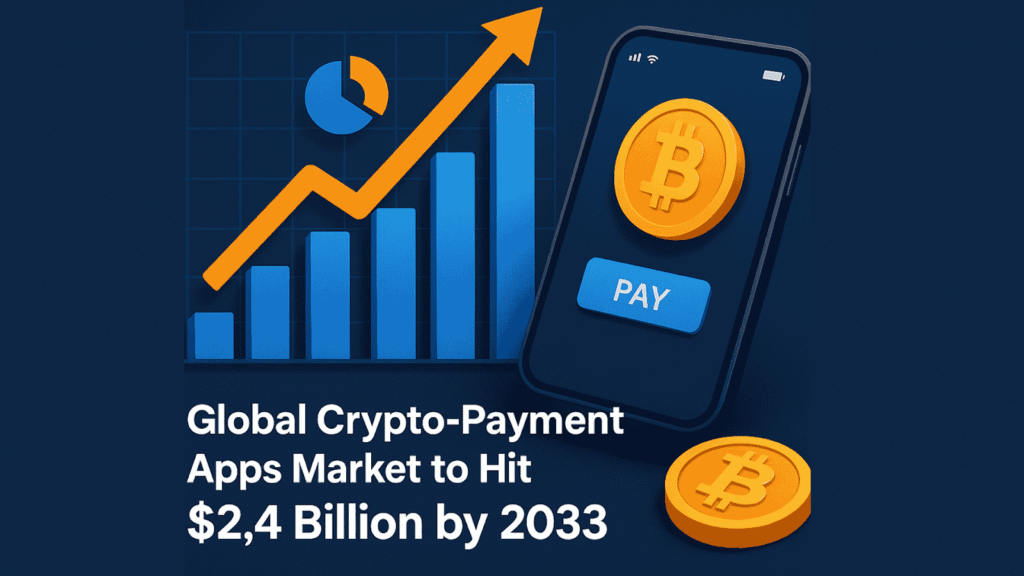A recent study by Grand View Research forecasts that the global cryptocurrency payment apps market will grow at a compound annual growth rate of 17.8%, reaching US $2.4 billion by 2033. With increasing consumer demand, especially in mobile-first regions like the Asia-Pacific, and steady regulatory clarity in Europe, the momentum toward digital asset payments is gaining real traction.
The market was valued at approximately US $557 million in 2024, with an estimated US $646 million projected for 2025, indicating the start of a sustained upward trend.
Regional Drivers and Diversified Adoption
Europe is playing a significant role in this expansion. Several EU member states are offering grants, tax incentives, and sandbox environments to foster blockchain innovation, helping drive adoption in the region. The United Kingdom, as a global fintech hub, is seeing substantial downloads of crypto payment apps under active engagement from regulatory bodies like the FCA.
Meanwhile, Asia-Pacific is expected to grow at a 13.1% CAGR between 2025 and 2033, supported by surging mobile internet usage and increasing crypto exchange access. India stands out with one of the fastest anticipated growth rates, driven largely by retail interest and rising wallet adoption.
Why the Market Is Scaling Fast
Several interconnected factors are fueling the crypto payment app boom:
- Mobile-first penetration: With smartphones ubiquitous worldwide, more consumers are using crypto wallets on mobile platforms.
- Retail and SME interest: Digital asset utility is expanding beyond speculation into real-world payments—facilitated by user-friendly apps.
- Regulatory support: Clear frameworks like Europe’s sandbox schemes and India’s retail crypto policies are letting innovation thrive.
- Digital tokens: Stablecoins and programmatic payment mechanisms are making crypto payments faster, cheaper, and more reliable.
Implications for Industry Stakeholders
This market growth signals profound changes across multiple sectors:
- Fintech models: Banks and payment providers are integrating crypto options to stay competitive.
- Merchant adoption: Vendors—from online stores to service providers—are beginning to accept cryptocurrencies as payment.
- User convenience: Seamless, token-based payments can accelerate global remittances, cross-border commerce, and micropayments.
Strategic Outlook for 2025–2033
The path ahead is promising. With projected growth to US $2.4 billion by 2033, the industry is entering a phase where mainstream adoption becomes feasible. Critical success factors include:
- Competitive Differentiation: App providers must balance security with seamless user experience.
- Localised Solutions: Tailoring features for regional payment needs and regulatory norms will be essential.
- Token Versatility: Support for stablecoins, CBDC pilots, and interoperability with legacy finance systems will drive usage.
What Comes Next for Web3 Payments
As crypto payments become increasingly integrated into fintech ecosystems, several key trends will likely shape the future:
- Cross-border settlements: Crypto offers near-instant, low-fee payment rails for international transactions.
- Embedded payments: Wallet apps are evolving into comprehensive financial hubs, offering lending, staking, and identity services alongside payment tools.
- Institutional engagement: Stablecoin-based AP payment systems for corporates and SMEs are expected to emerge soon.
Final Thoughts
With an expected CAGR of 17.8% and a projected valuation of US $2.4 billion by 2033, the global crypto-payment apps market is poised for transformative growth. As digital assets continue moving from niche usage to everyday utility, these payment platforms will become integral to the future of digital finance, crossing the divide between decentralized technology and mainstream financial services.


